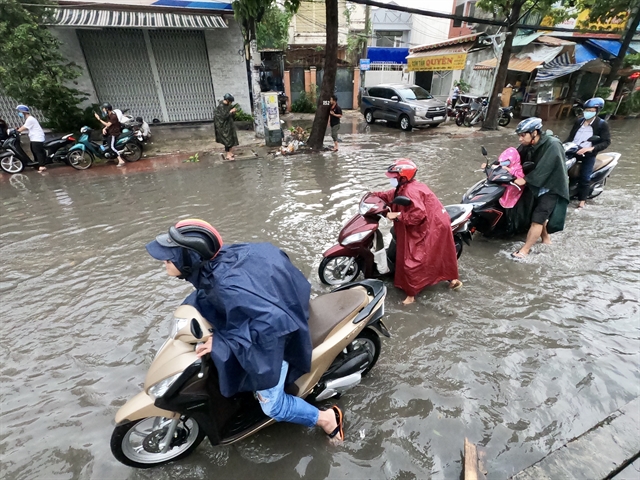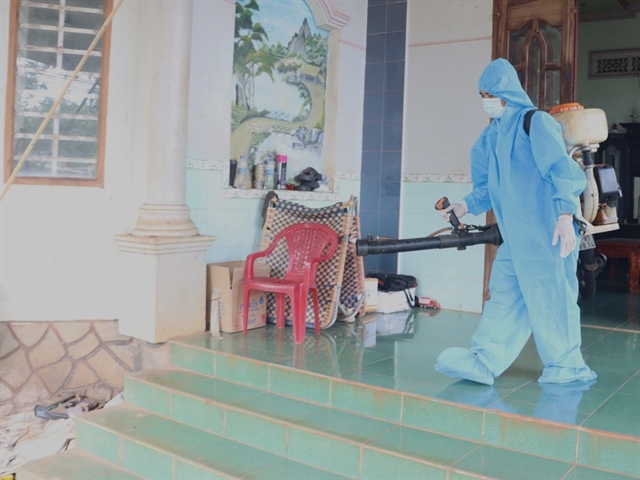 Environment
Environment


|
| A street in HCM City flooded during the heavy rains on June 3. — VNA/VNS Photo Hồng Giang |
HCM CITY— The anti-flooding works carried out in HCM City since 2008 have helped reduce the number of streets that are flooded during moderate to heavy rainfall, according to the city Department of Construction.
The city had three heavy spells of rain since this year with rainfall of 70.6-112.3mm within two hours.
It caused flooding of 0.1-0.3 metres along Nguyễn Hữu Cảnh, Điện Biên Phủ and Ung Văn Khiêm streets in Bình Thạnh District, Quốc Hương and Nguyễn Văn Hưởng in District 2, Phan Huy Ích, Phạm Văn Chiêu, and Lê Đức Thọ in Gò Vấp District, Phạm Văn Đồng, Tô Ngọc Văn and Kha Vạn Cân in Thủ Đức District, Nguyễn Văn Quá and Lê Văn Lương in District 12, and Hồ Học Lãm in Bình Tân District.
But they drained within 10-15 minutes after the rains stopped, Vũ Văn Điệp, director of the HCM City Infrastructure Management Centre, was quoted as saying by Sài Gòn Giải Phóng (Liberated Sài Gòn) newspaper.
In 2008 the city had 125 flooded streets, and it took much longer for the water to drain.
According to Lê Hòa Bình, the department’s director, streets such as Ba Tháng Hai, Lê Hồng Phong and Trần Khánh Dư streets, the Cây Gõ Roundabout, the Chợ Lớn Bus Station, highway Nos.43 and 1, Hai Bà Trưng, Trần Nhật Duật, Trần Quang Khải, and areas in wards 17, 21, and 25 in Bình Thạnh District used to be heavily flooded in the past, but are not flooded any more despite heavy rainfall and high tides.
The city targets completely mitigating by this year flooding in the centre and five peripheral areas spread over 550 square kilometres and with nearly 6.5 million residents.
The water environment has been improved and storage space has been increased, and the urban landscape has been upgraded to improve the life of people and protect the environment.
Now 25 out of the 36 worst flooded streets are no longer flooded, accounting for 70 per cent of the target in the 2016-2020 programme.
The city connected another 1,164 more alleys to the drainage system, and so most of them are no longer flooded.
Lương Định Của, Nguyễn Văn Hưởng, Xa Lộ Hà Nội, Huỳnh Tấn Phát, Lê Văn Lương, Trần Xuân Soạn, highway Nos. 10 and 50, and street No. 26, usually flooded by tides, are expected to be no longer flooded from this year’s end.
Nguyễn Hữu Cảnh Street, which was heavily flooded recently, is being upgraded to prevent flooding, and has been installed with pumps. The upgrade is expected to be completed in April 2021, ending the flooding.
The city still faces challenges to its flood-prevention efforts, such as the rapid urbanisation, continuing subsidence and, especially, climate change, according to Binh.
The Department of Construction plans to carry out more works to avoid flooding in the city.
The centre has assigned its staff to pick garbage from the drainage system and operate pumps. They are stationed in areas where flooding is likely to occur to clear it in time.
Earlier, HCM City authorities have asked agencies to roll out policies to attract private investment for flood-prevention projects.
Speaking at a recent meeting, Võ Văn Hoan, deputy chairman of the city People’s Committee, asked the Construction Department and Planning and Investment Department to develop policies to solicit funds, especially for projects under public-private partnerships.
Regular inspections will be carried out to resolve problems arising during construction, and meetings will be organised every six months with a review at the end of the year.
The Department of Science and Technology has been instructed to apply modern technologies to drainage systems, wastewater treatment, reservoirs, embankments, and underground water tanks.
City authorities will also crack down on illegal encroachments on rivers, canals, and drainage systems.
Flooding risks in HCM City may grow 10 times more intense by 2050 given the current prevalence of poorly regulated construction projects and economic activities, according to a new study by the international consulting firm McKinsey.
According to the findings, the city may lose billions of US dollars to sea-level rise and a majority of its area may become vulnerable to extreme weather events without serious adaptation and systemic reform of urban planning.
According to the Ministry of Natural Resources and Environment, a survey of 339 locations in the Mekong Delta and HCM City last year found that 306 have sunk by 0.1 to 81.4 centimetres over the last decade, including 19 locations in the city. — VNS




